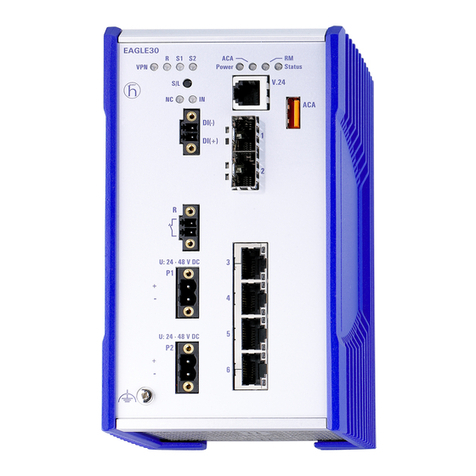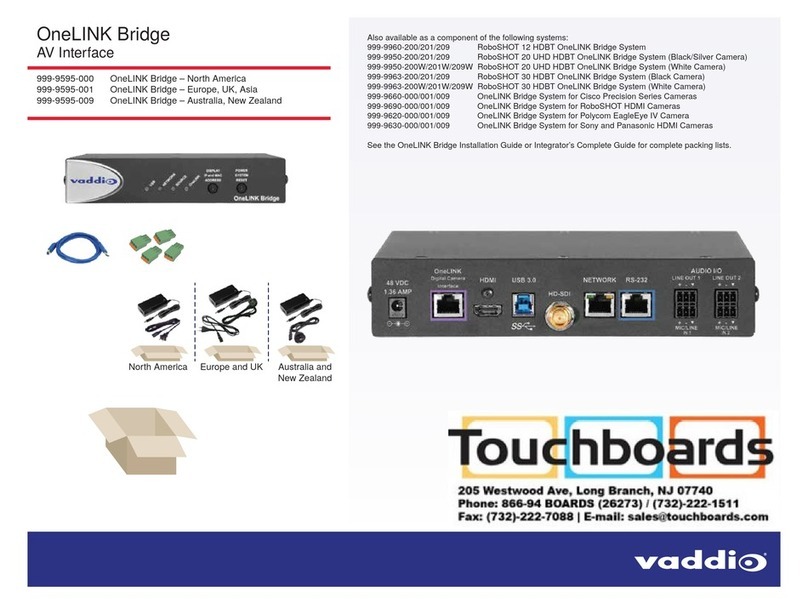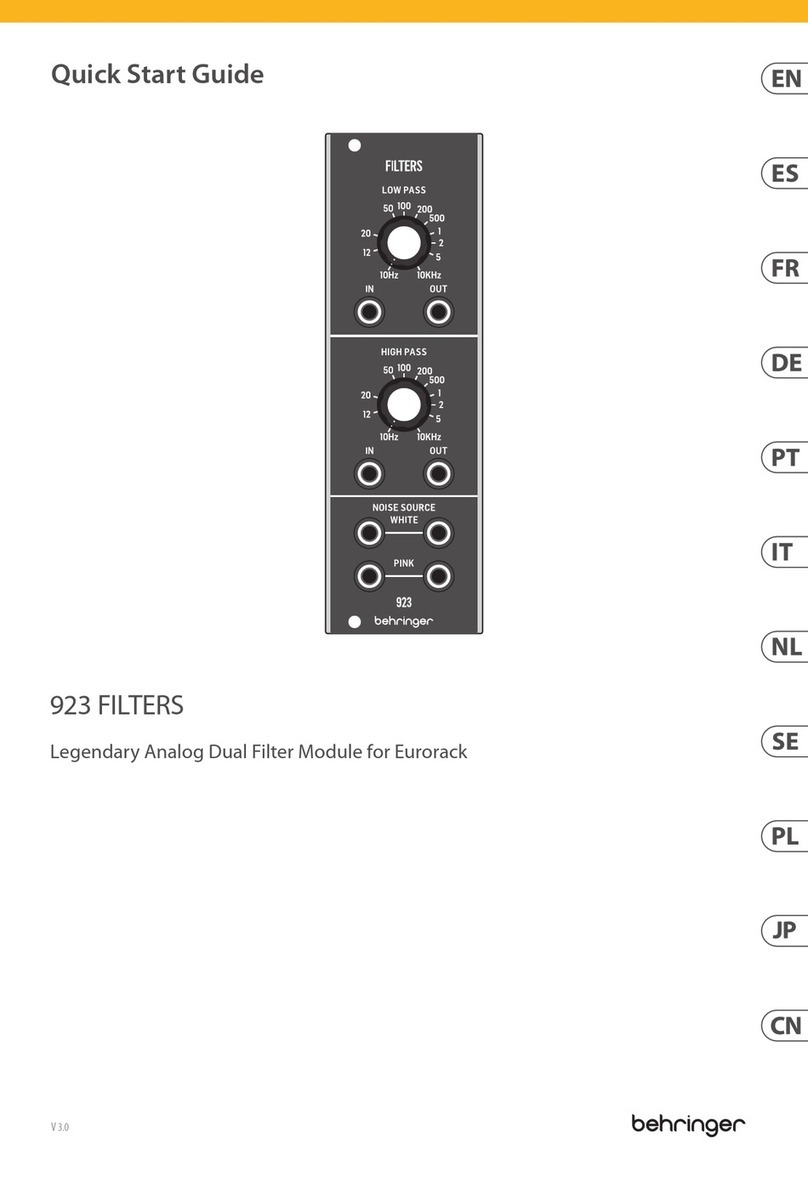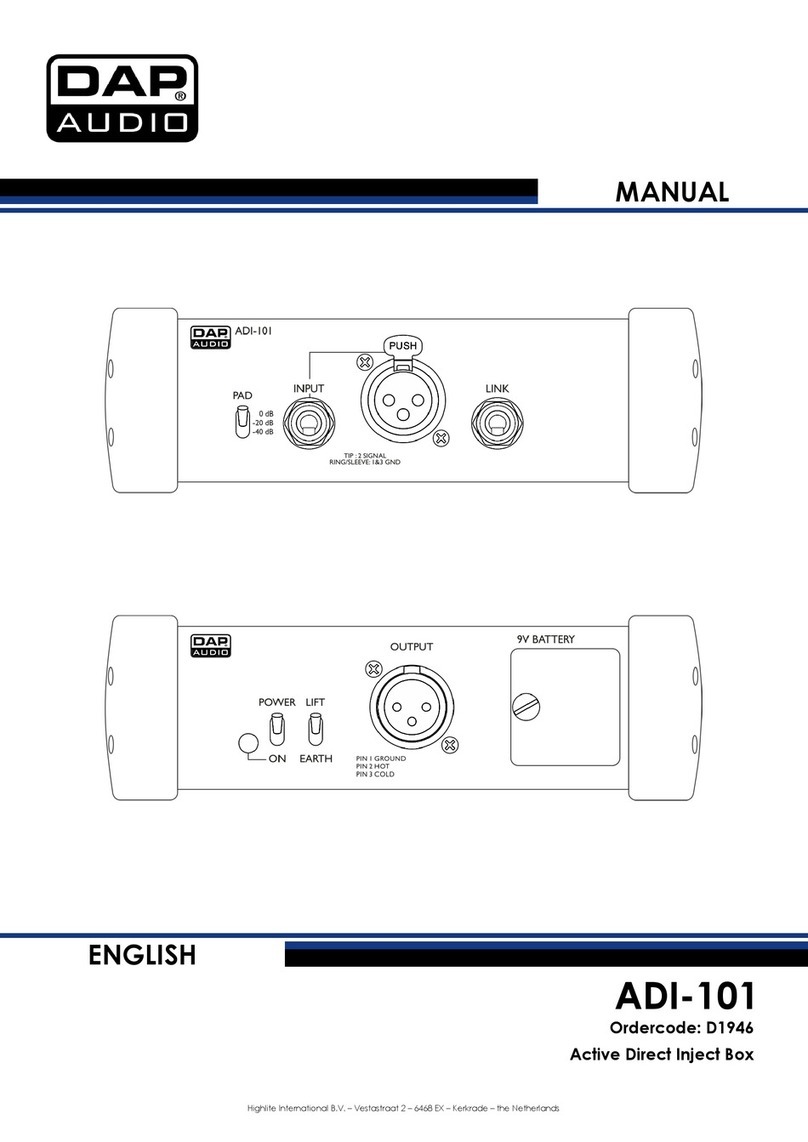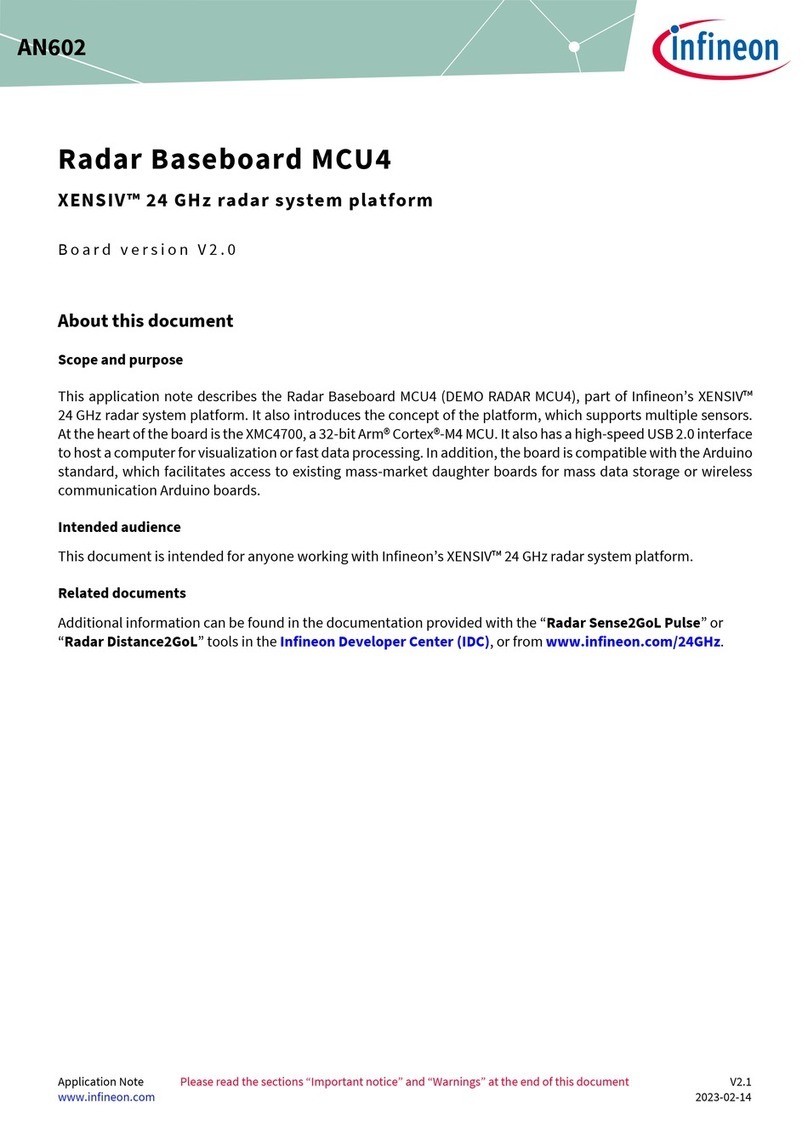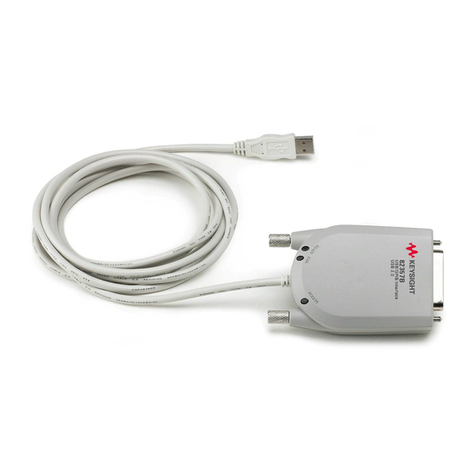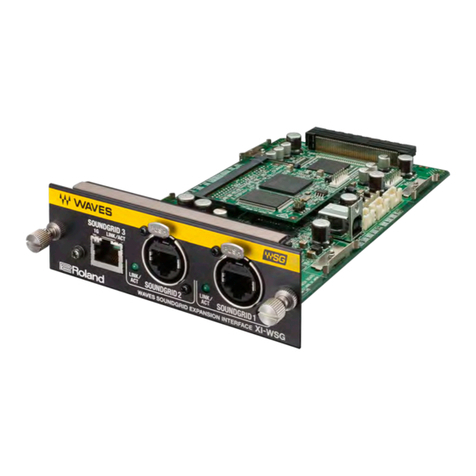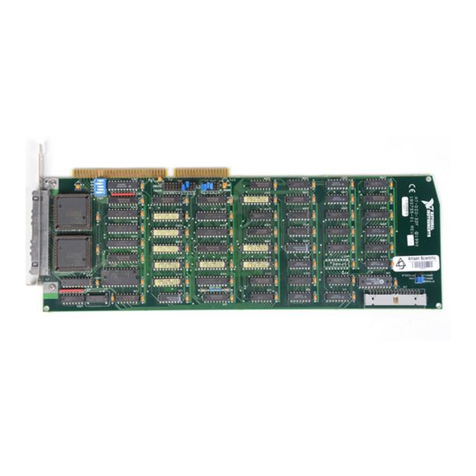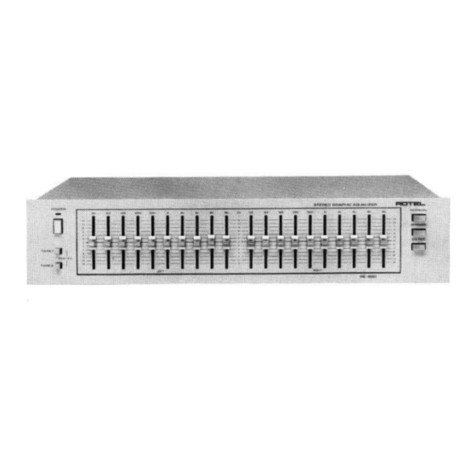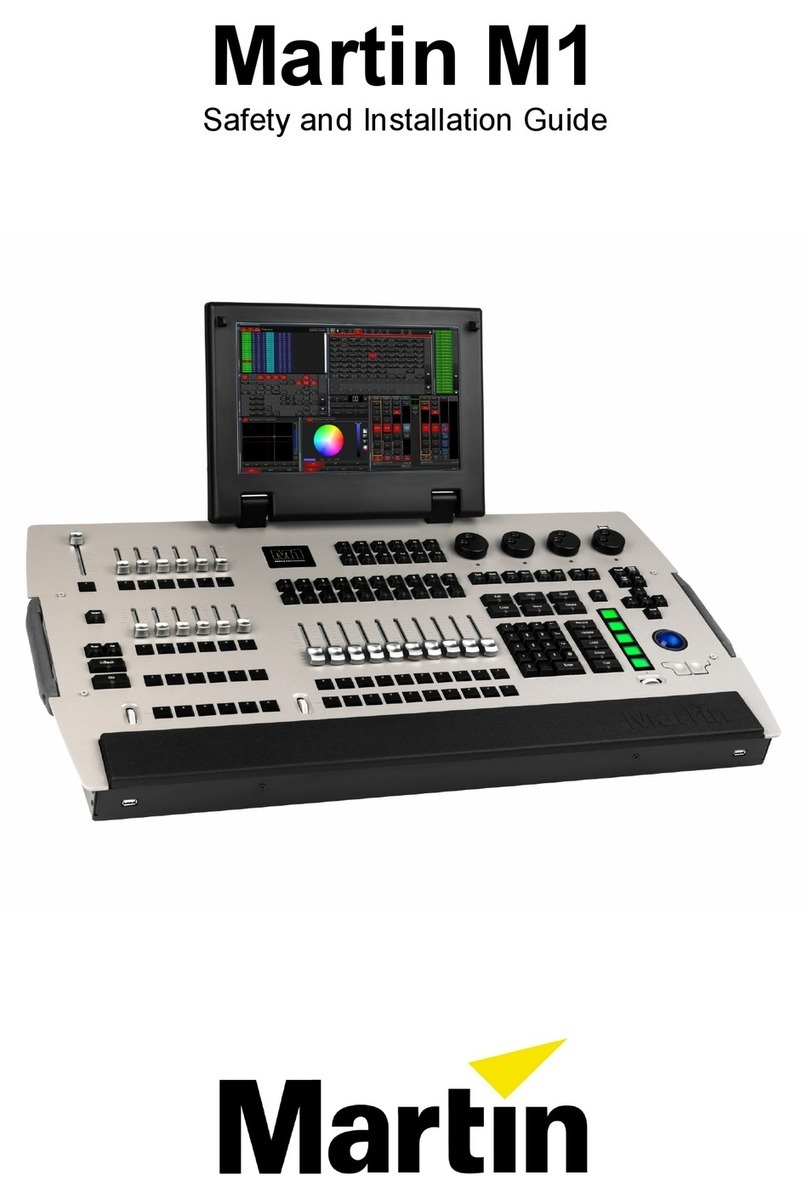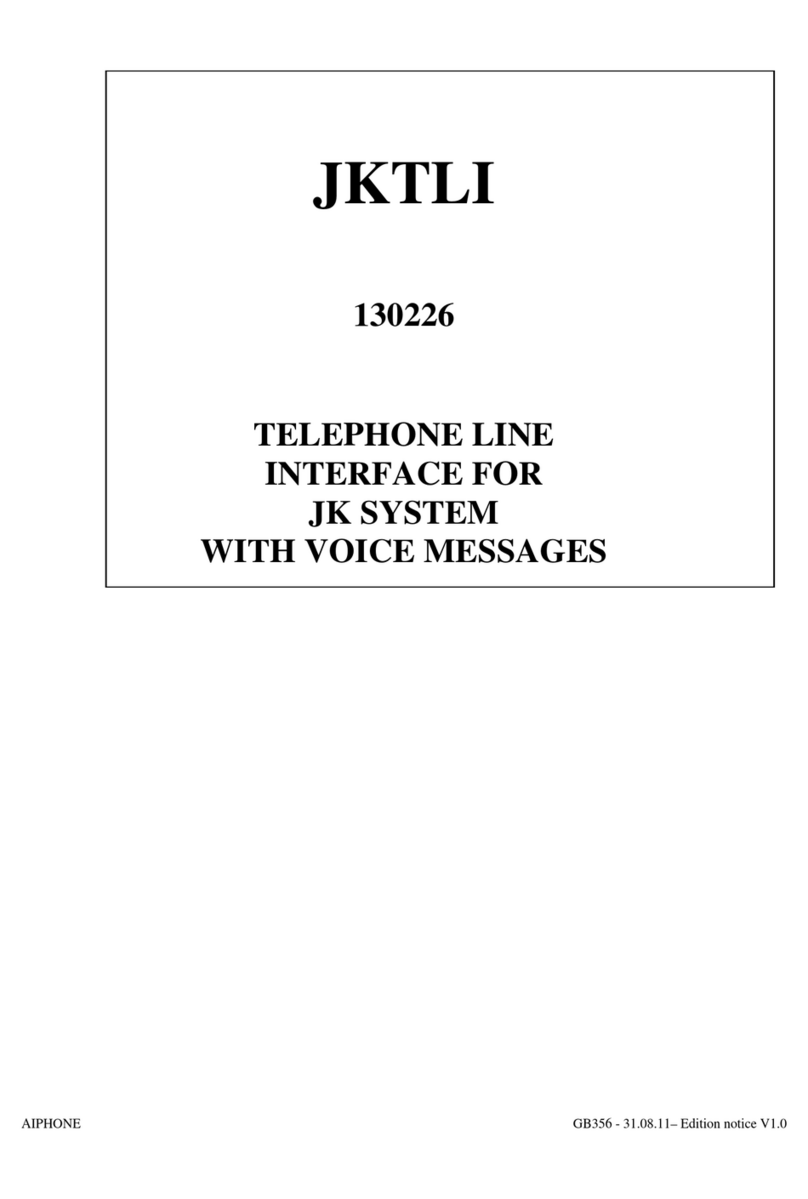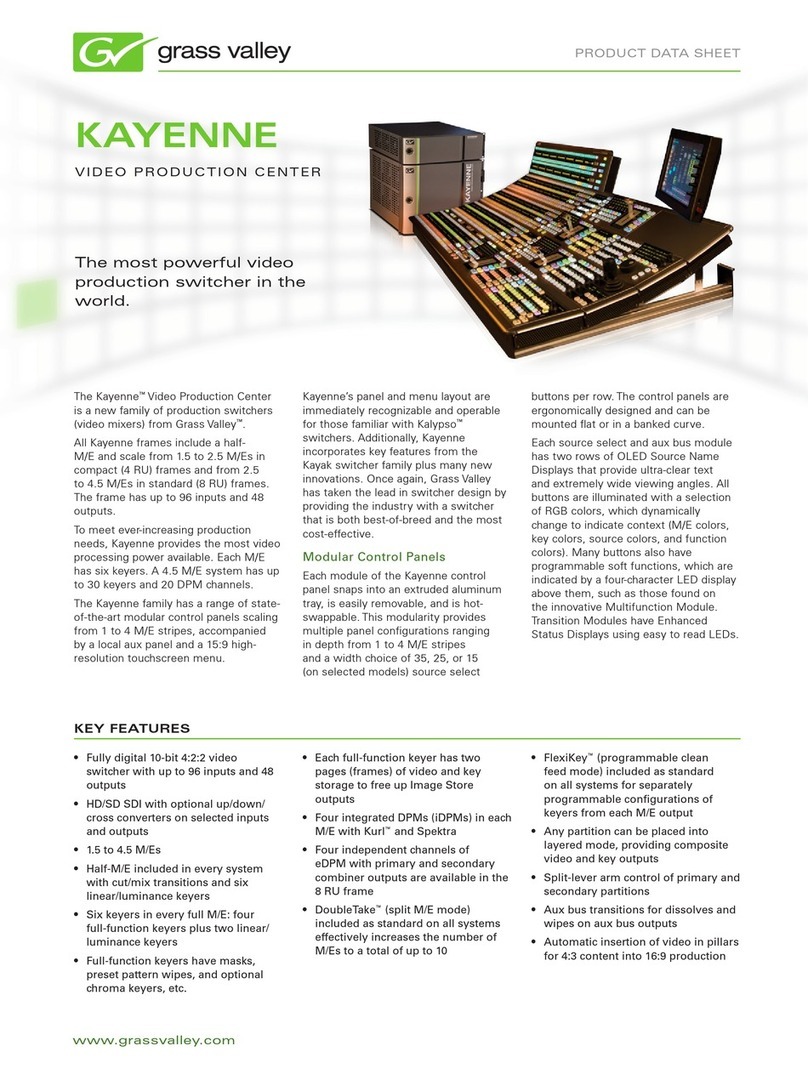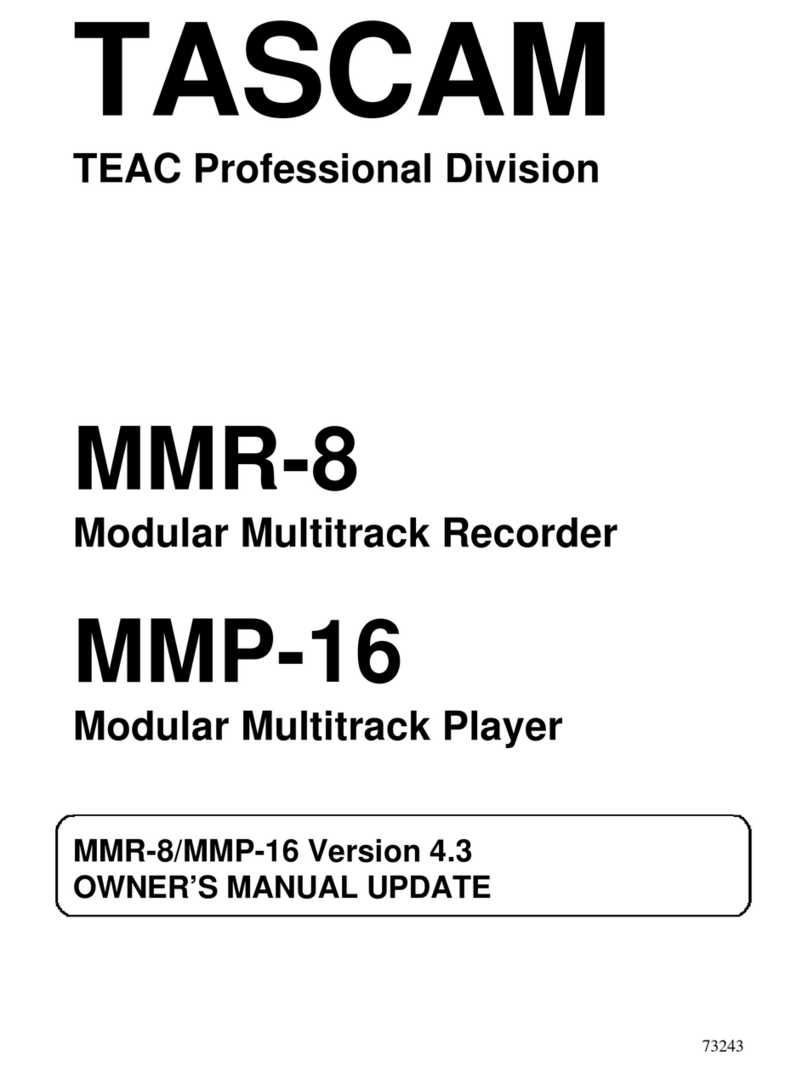Hirschmann PAT TRS 05 User manual

TRS 05
OPERATOR’S / SERVICE MANUAL

P/N 031-300-190-176 Revision B 01/25/2005


Operator’s/Installation/Service Manual
TRS 05
TABLE OF CONTENTS
1
GENERAL INFORMATION ............................................................................................................1
2
WARNINGS ..................................................................................................................................1
3
FEATURES...................................................................................................................................2
4
SYSTEM DESCRIPTION..............................................................................................................2
Receiver Module........................................................................................................................2
LEDs ..............................................................................................................................................3
Control Identification.......................................................................................................................3
5
OPERATION.................................................................................................................................4
Receiver ....................................................................................................................................4
Transmitter ................................................................................................................................5
Repeater....................................................................................................................................5
6
INSTALLATION.............................................................................................................................6
Receiver ....................................................................................................................................6
Repeater....................................................................................................................................7
Load Cell Installation..................................................................................................................7
7
CALIBRATION..............................................................................................................................7
Install Sensor / Transmitter........................................................................................................7
Uninstall Sensor / Transmitter....................................................................................................7
Sensor Output Setup .................................................................................................................8
Hardware........................................................................................................................................8
Software.........................................................................................................................................8
Load Sensor Calibration.............................................................................................................8
Calibration Mode.............................................................................................................................8
Set Zero Point...............................................................................................................................10
Gain Adjustment...........................................................................................................................10
Accuracy and Test Requirements..................................................................................................10
Calibration overview.................................................................................................................12
8
SERVICE AND TROUBLESHOOTING .......................................................................................13
Service.....................................................................................................................................13
Troubleshooting.......................................................................................................................13
Receiver.......................................................................................................................................13
Repeater.......................................................................................................................................14
Troubleshooting Moisture.........................................................................................................14
9
MAINTENANCE..........................................................................................................................15
Battery Replacement ...............................................................................................................15
10
SPARE PART NUMBERS...........................................................................................................16
General Information 1

Operator’s/Installation/Service Manual
TRS 05
The system can only work correctly, if all sensors/transmitters have been properly set. For
correct setup, the operator has correctly complete all procedures in this manual, the system
manual, and the setup procedure in accordance with the real rigging state of the crane. To
prevent material damage and serious or even fatal accidents, the correct adjustment of the
system has to be ensured before starting the crane operation.
Always refer to operational instructions and load charts provided by the crane manufacturer
for specific crane operation and load limits.
1
GENERAL INFORMATION
The PAT TRS 05 system interface has been designed to use radio communication for load sensors.
The TRS 05 receives a radio signal from a transmitter sensor and converts a signal as a replacement
for the existing hardwired sensor.
Review system operator’s manual for system description and operation. All system functions and error
codes will remain the same for the DS350 system.
This manual will describe the operation, sensors setup and calibration, and additional troubleshooting
points for the TRS 05.
2
WARNINGS
Review system operator’s manual for system warnings.
The responsibility for the safe operation of the crane remains with the crane operator who must ensure
that all warnings and instructions supplied are fully understood and observed.
Prior to operating the crane, the operator must carefully and thoroughly read and understand the
information in this manual and the system manual to ensure that the operation and limitations of the
system and the crane are known.

Operator’s/Installation/Service Manual
TRS 05
Red Power LED
Red Alarm LED
Sensor On Line
Green LED 1
Green LED 2
Green LED 3
Green LED 4
Sensor Low Battery
Yellow LED 1
Yellow LED 2
Yellow LED 3
Yellow LED 4
3
FEATURES
The PAT TRS 05 has the following features:
Can be hardwired to most PAT systems, and certain crane systems.
Wireless operation of 4 sensors.
Minimum of 500 feet LOS.
Easily and clearly shows the operator required information for the radio sensor.
o
Power LED (red)
o
Link condition LED (green), LED on sensor installed and linked, LED flashing installed
but link or communication has been lost, and LED off sensor not installed.
o
Low battery indication LED (yellow)
o
Warning of Error LED (red)
4
SYSTEM DESCRIPTION
RECEIVER MODULE
The receiver module has the following functions:
Visual indication of receiver power, radio links (sensor on line), sensors low battery, and alarm
conditions.
Installs/uninstalls a sensor
Allows a zero point and output adjustment of a load sensor.

System Description 3
LEDs
Red Power LED Power is applied to the circuit board.
Red alarm LED An installed sensor is indicating an alarm, or communication as been
lost to an installed sensor.
Green LED 1 ON Sensor on channel #1 is installed and communicating correctly.
Green LED 1 FLASHING Sensor #1 is not communicating correctly.
Green LED 1 OFF No sensor is installed on channel #1.
Yellow LED 1 ON Sensor #1 batteries are low and need replaced. Note that the sensor
is still operating correctly.
Green LED 2 ON Sensor #2 is installed and communicating correctly.
Green LED 2 FLASHING Sensor #2 is not communicating correctly.
Green LED 2 OFF No sensor is installed on channel #2.
Yellow LED 2 ON Sensor #2 batteries are low and need replaced. Note that the sensor
is still operating correctly.
Green LED 3 ON Sensor #3 is installed and communicating correctly.
Green LED 3 FLASHING Sensor #3 is not communicating correctly.
Green LED 3 OFF No sensor is installed on channel #3.
Yellow LED 3 ON Sensor #3 batteries are low and need replaced. Note that the sensor
is still operating correctly.
Green LED 4 ON Sensor #4 is installed and communicating correctly.
Green LED 4 FLASHING Sensor #4 is not communicating correctly.
Green LED 4 OFF No sensor is installed on channel #4.
Yellow LED 4 ON Sensor #4 batteries are low and need replaced. Note that the sensor
is still operating correctly.
Green Heartbeat LED This will flash during normal operation. If it is a solid or off, the
receiver has a software error or the board has a component failure.
Control Identification
Sensor #1 output jumper J4
Sensor #2 output jumper J3
Sensor #3 output jumper J2
Sensor #4 output jumper J1
ID button
power (red), sensor link 1-4 left
to right (green)
LEDS
1-4 left to right (yellow)
LEDS Green Heartbeat LED
(located just under radio module)
software chip
radio module 031-300-300-024

Heartbeat LED: When blinking, this small surface board mounted green LED indicates the system is
operation properly.
ID button: The red ID button, located below the software chip on the receiver board, is used to setup
the sensor transmitter to the receiver.
5
OPERATION
RECEIVER
Upon switching on crane ignition switch, the system starts with an automatic test of the receiver board,
LEDs and electronic components. The red power LED should be on and the green LEDs that sensors
have been linked to should also be on.
If an alarm condition exists investigate and clear the condition before operation and using the system.
During the normal operation of the system, the POWER and SENSOR ON LINE (if linked to a sensor)
LEDs should be on.
POWER LED
The POWER LED shows that the receiver is getting power from the crane. The receiver is on any time
the crane is operating and supplying power to the system.
SENSOR ON LINE LED
The SENSOR ON LINE LED indicates the status of communication of the transmitter(s). During
normal operation of the system, the LED will be on. The LED will flash if communication or
transmission between the sensor transmitter and the receiver is interrupted or lost. The system should
not be operated if the SENSOR ON LINE LED is flashing. If the LED is off no sensor is linked to this
channel.
LOW BATTERY LED
The low battery indicator will light indicating that you have a limited time to operate before the sensor
battery life ends. When the battery level is to the point that it is too low to operate, the system will stop
functioning. Use any off-the-shelf alkaline C-cells; Duracell, Eveready, etc.
ALARM LED
This LED will light simultaneously with the engaging of the lock out solenoids (if installed).
Test the electronics
Cycle the power to the system, each LED on the receiver will light for 2 seconds when the system is
powered. All of the indicator lights must come on or the system is not functioning properly. If any light
does not function, do not use the system until it has been repaired.
Refer to receiver operating manual for pre-operational inspection.
If a green sensor on line LED starts to flash, this means a sensor is installed and the communication
link has been lost. When communication has been lost to a load cell, the receiver will output the
maximum voltage signal for the output sensor (9VDC).
If a low battery LED is on, replace the batteries in the linked transmitter, refer to Battery Replacement.
The TRS 05 setup/calibration procedure allows the operator to input the type of sensors being used,
and adjust the zero point and output adjustment of a load sensor. The operator must complete the

setup procedure for each sensor.

Operation 5
TRANSMITTER
The transmitter has an LED that will flash when a signal is transmitted to the receiver.
Load Cell
The load cell transmits once every 1 to 2 seconds when in standby, and 2 times a second when the
load changes. It will continue at 2 times a second for less than a 1 minute before dropping back to one
transmission every 1 to 2 seconds. There is no time it goes to sleep.
Note: To extend battery life, remove batteries from transmitter(s) if load cell(s) will not be used for
extended periods of time. Reinstalling batteries to the transmitter should not require a console set up.
REPEATER
The repeater is setup from the factory to repeat signals from the load cells to the TRS 05 receiver.
Therefore, there is setup or calibration required for the repeater. Upon switching on the repeater from
the crane ignition switch, the system starts with an automatic test of the repeater board, LEDs, and
electronic components. The red power LED should be on and other red LED blinks when the repeater
is transmitting a signal.
The repeater will receive numerous ID code and transmit the same ID code.

Calibration
6
6
INSTALLATION
RECEIVER
The receiver module should be mounted so the operator can view the LEDs and setup the system for
operation. The location of the receiver should be in direct line of site of the transmitter and blocked by
as little metal as possible between the transmitter and receiver. However, in some cases the receiver
has been installed surrounded by metal and worked well. The location needs to be tested before
mounting the hardware. If the signal is lost, the box/receiver indicates a link error.
Securely attach the receiver onto a solid surface using the mounting holes.
Power cable connections are show above.
SENSOR ON LINE
POWER 1
2
3
4
ALARM 1
2
3
4
SENSOR LOW BATTERY
Model: PAT TRS 05
This device complies with Part 15 of the FCC rules.
Operation is subject to the following two conditions:
(1) This device maynot cause harmful interference,
and (2) this device must accept interference that may
cause undesired operation.

Calibration
7
While the ID button is held or in the calibration process, the sensor outputs will not correctly indicate
the status of other installed sensors. Correct operation will return when the menu is exited or
calibration process is complete or system is powered off/on.
REPEATER
The repeater module is mounted on the boom tip in line of sight to the receiver and the load cell. The
main purpose of the repeater is to receive and transmit the load cell ID code of the load cell during
operation. If the load cell line of sight is obstructed by a barrier (i.e. wall or building), the repeater
should prevent and signal loss.
LOAD CELL INSTALLATION
NOTE: After installation the load cell will need to be zeroed with no force applied and adjusted a
permissible heavy load.
The load cell and plates are installed at the dead end of the wire rope that is being used to lift the load.
The appropriate pins (length and diameter) for the type and size of socket, block, or ball must be used.
Ensure that the correct pin used is rated for the maximum line pull capacity. Install the plate using the
2-1/4” pin so the pin head is on the antenna side. Ensure all safety pins are installed properly with
washers and bushing to fit the hole diameter and pin length.
7
CALIBRATION
The sensor setup and calibration is completed with the one ID button, pressing it starts the menu and
releasing the button selects the menu or action the operator want to complete. If an incorrect menu is
activated or the button is released accidentally, simply cycle the power and start over.
INSTALL SENSOR / TRANSMITTER
Press and hold the ID button for 3-5 second the 1st green LEDs will begin blinking. If the button is held
for 3-5 more seconds the 2nd LED will begin to blink, continue holding the button and the setup
program will cycle through the 4 sensor channels. When the correct LED is blinking, channel to be
installed, release the ID button, the receiver begins to search for a transmitter ID code. The green LED
will become solid when the transmitter is linked.
As the ID button is held and released at the blinking LED, the following actions will occur:
Green LED 1 Blinking: Search for / Install sensor 1. LED will turn solid when the sensor is found.
Green LED 2 Blinking: Search for / Install sensor 2. LED will turn solid when the sensor is found.
NOTE: A new sensor or transmitter maybe install over an existing link, when this occurs the previous
link and code are removed from memory and the new one stored.
UNINSTALL SENSOR / TRANSMITTER
If a sensor is setup on the channel the LED will be on, press and hold the ID button (16-28 seconds)
through the Install Sensor mode (blinking LEDs1-4) until the correct 1-4 LED is solid. When the correct
LED is solid, channel to be uninstalled, release the ID button. The sensor for the selected

Calibration
8
channel/LED 1-4 will be uninstalled and the system will be in normal operating mode.

Calibration
9
Voltage position
As the ID button is held (16-28 seconds) through the Install Sensor mode (blinking LEDs1-4) and
released at the solid LED, the following actions will occur:
Green LED 1 solid: Uninstall sensor 1.
Green LED 2 solid: Uninstall sensor 2.
Green LED 3 solid: Uninstall sensor 3.
Green LED 4 solid: Uninstall sensor 4.
SENSOR OUTPUT SETUP
The sensor output is setup for the hardware (bridge place on jumpers 1 & 2, as shown below) and
software (use the ID button software output). If the hardware and software do not match an error will
occur.
Hardware
Install the bridge in the voltage position on jumpers 1 and 2, as show above. If a sensor is not installed
on channels 3 and 4, the bridges and jumpers will not effect the operation of the unit.
Software
Hold the ID button for about 37-40 seconds until all 4 yellow LEDs are blinking and released ID button
to set all the analog outputs for 1.0 –9.0VDC voltage.
LOAD SENSOR CALIBRATION
To calibrate the load, there will need to be a zero point and gain adjustments. The zero point must be
a no load adjustment and the gain adjustment is at least a 70% permissible load adjustment.
Calibration Mode
Before calibration a load cell must be installed the output setup, refer to Install Sensor / Transmitter
and Sensor Output Setup. The load cell must be calibrated to ensure accuracy. This is done by
pressing and holding the ID button on the PC board (38-50 seconds), through the Install Sensor mode
(blinking LEDs1-4), Uninstall Sensor mode (solid LEDs1-4), and Sensor Outputs (all 4 LED blinking

Calibration
10
and solid), when the correct green and yellow LEDs are blinking, channel to be calibrated, release the
ID button, the following actions will occur:
Yellow & Green LEDs 1 Blinking: Calibrate sensor 1
Yellow & Green LEDs 2 Blinking: Calibrate sensor 2
Yellow & Green LEDs 3 Blinking: Calibrate sensor 3
Yellow & Green LEDs 4 Blinking: Calibrate sensor 4
The receiver is placed into calibration mode, indicated by the solid green and yellow LED.
NOTE: The unit will remain in calibration mode until power is cycled off/on.
LED on increase load
LED off decrease load
Power on
Blinking yellow and green LED
calibrate channel/sensor #1
Blinking yellow and green LED
calibrate channel/sensor #2
The example in the picture shows, sensor/channel #1 in calibration mode and pressing the ID button
will increase the load.
Calibration mode is when the ID button is used to increase or decrease the displayed load to match
the actual load. If the alarm LED is on, when the ID button is press the displayed load will increased
until the button is released and the LED will go off. If the alarm LED is off, when the ID button is press
the displayed load will decreased until the button is released and the LED will come on.
Next the zero point and gain adjustments must be setup. The zero point must be a no load adjustment
and the gain adjustment is at least a 70% permissible load adjustment.

Calibration
11
Set Zero Point
To set the zero point of the load cell, ensure that no load is hung on the load cell, including any hook
block, lengths of cable, etc. The software will only allow the load cell zeroed when there is no load on
the load cell. If there is a load on the load cell, the software will define this as a gain adjustment.
Pressing, hold, and release the ID button until the displayed load is zero.
The LEDs will not change after zero point has been set.
Gain Adjustment
To calibrate the gain of the load cell, a known load must be lifted, refer to Accuracy and Test
Requirements below, before completing the calibration. Ideally, the load should be as heavy as
permissible given the load cell and crane configuration chosen. When calculating the load on the load
cell, it must be remembered to add the weight of any headache ball, hook block, and rope used
(depending on load cell location).
The software automatically switches from zero point to the gain adjustment when a load is applied to
the load cell.
View the load reading on the LMI or other display, and use the ID button to increase or decrease the
reading as necessary, in the same manner as was used to adjust the zero point.
When calibration is completed, re-check the zero point with a very light load, and repeat any
adjustments necessary. The zero point adjustment will have an even affect across the entire range (for
example, 200 lb at both low and high loads). The gain adjustment will have only a small effect on light
loads, but a large effect on heavy loads.
If a new load cell is installed, or the load cell is uninstalled and re-installed, the calibrations must be
repeated. Installing a load cell causes the calibrations to revert to their default settings.
There is no way to exit the calibration mode other than to remove power from the receiver module.
Calibration settings are saved to long term storage each time the ID button is released. It is not
advisable to operate the crane under calibration mode, other than what is necessary to complete the
calibration.
Accuracy and Test Requirements
Check the load display by lifting a load of known weight. The accuracy of the load indication shall be
within the tolerance of SAE J376, refer to complete SAE standard before testing.
Accuracy
The accuracy of the load indicating system is to be such that the indicated load is not less than 100%
of the actual load, nor more than 110% of the actual load. Where the system cannot meet the
accuracy criteria at the lower load range, conspicuous labeling or signaling is to be provided indicating
that these accuracy criteria cannot be met.
The weight of the load being lifted and all additional equipment such as blocks, slings, sensors, etc.;

Calibration
12
also referred to as working load.

Calibration
13
Test Requirements
System tests are to be conducted using an appropriate configured crane and specified load rating
chart.
For system calibration, three or more test radii or boom angle are to be employed to establish
compliance with the accuracy section above. Test loads shall be as near as is practical to minimum,
mean, and maximum values within the operating limits.
One of the following test methods or equivalent is to be used:
Known Weight
Test load to be applied by suspending known weights accurate to ± 1%. If the weights of all
additional equipment such as blocks, slings, sensors, etc., are included in the test load, the total
load is to be known to an accuracy of ± 1%.
Fixed Anchor (Deadman)
Test load to be applied by hoisting against a fixed anchor or deadman equipped with a means for
measuring loads accurate to ± 1%. If the weights of all additional equipment such as blocks,
slings, sensors, etc., are included in the test load, the total load is to be known to an accuracy of ±
1%.
The system accuracy is to be determined from the following formula:
Indicated Load x 100 = % of Load
Actual Load

Calibration
14
CALIBRATION OVERVIEW
This section is a basic overview of Section 7 Calibration. Press and hold ID button, release the button
at the desired indication (or the number seconds) defined in the following table. The following table
can be use as a quick reference guide when calibrating the load cell; however, the Accuracy and Test
Requirements must be followed to complete the calibration procedure.
NOTE: If an incorrect menu is activated or the button is released accidentally, simply cycle the power
and start over.
Menu Selection Release ID Button Indication Indication
Starts (Sec) Indication
Ends (Sec)
Install/setup sensor on channel 1 blinking green LED 1 3 6
Install/setup sensor on channel 2 blinking green LED 2 6 9
Install/setup sensor on channel 3 blinking green LED 3 9 12
Install/setup sensor on channel 4 blinking green LED 4 12 15
Uninstall a sensor on channel 1 solid LED 1 16 19
Uninstall a sensor on channel 2 solid LED 2 19 22
Uninstall a sensor on channel 3 solid LED 3 22 25
Uninstall a sensor on channel 4 solid LED 4 25 28
Set all the analog outputs for voltage 0-5V All 4 green LEDs blinking 29 32
Set all the analog outputs for 4..20ma All 4 green LEDs solid 33 36
Set all the analog outputs for voltage 1-9V All 4 yellow LEDs blinking 37 40
Set all the analog outputs for voltage 0-9V All 4 yellow LEDs solid 40 43
Calibrate load/angle sensor on channel 1 blinking yellow & green LEDs 1 43 46
Calibrate load/angle sensor on channel 2 blinking yellow & green LEDs 2 46 49
Calibrate load/angle sensor on channel 3 blinking yellow & green LEDs 3 50 53
Calibrate load/angle sensor on channel 4 blinking yellow & green LEDs 4 53 56
Service information on channel 1 blinking yellow LED 1 56 59
Service information on channel 2 blinking yellow LED 2 59 63
Service information on channel 3 blinking yellow LED 3 63 66
Service information on channel 4 blinking yellow LED 4 67 70
Exit/No action LEDs off no 71
ID button
LEDS
power (red), sensor link 1-4 left to right (green)
1-4 left to right (yellow)
LEDS Green Heartbeat LED
(located just under radio module)
software chip
radio module 031-300-300-024

Service and Troubleshooting 13
8
SERVICE AND TROUBLESHOOTING
SERVICE
Daily maintenance of the system consists of inspecting:
1.
The electrical wiring connecting the various parts of the system.
2.
If electrical wiring is damaged, it shall be replaced immediately.
3.
If the insulation is worn on the electrical wiring or antennas are damaged, these parts shall be
replaced.
4.
A damaged or punctured housing or cover must be replaced immediately to prevent ingress of
water and damage to the internal circuitry.
Other than correcting the problems identified in the Malfunctions Table and replacing faulty
mechanical parts and cables, no other repairs shall be made.
TROUBLESHOOTING
Receiver
After the onboard diagnostics have been performed, follow these guidelines
Problem
Power LED does
not light
Communication
error
Communication
error
Communication
error
Communication
error
Communication
error
Transmitter LED
does not flash
Transmitter LED
does not flash
Cause
No power to
receiver
Low battery
Faulty sensor
Poor reception
Sensor not
installed.
Poor
communication
caused by
interference.
Sensor is asleep.
Batteries dead.
Solution
Make sure the receiver is getting power from the crane.
Check wiring.
Ensure correct polarity of the power.
Open receiver and check green blinking status of LED.
Verify which sensor is causing the error by looking at
the communication error screen.
Replace batteries.
Verify which sensor is causing the error by looking at
the communication error screen.
Verify that the LED on the sensor is blinking.
Verify which sensor is causing the error by looking at
the communication error screen.
Verify that the LED on the sensor is blinking.
Verify that the sensor is line of sight to the receiver.
Install the sensor on the receiver. See adding sensors
Remove potential interference sources from the area.
Mount the receiver in a different location.
Change the status of the sensor.
Replace the batteries.
Other manuals for PAT TRS 05
1
Table of contents
Other Hirschmann Recording Equipment manuals
